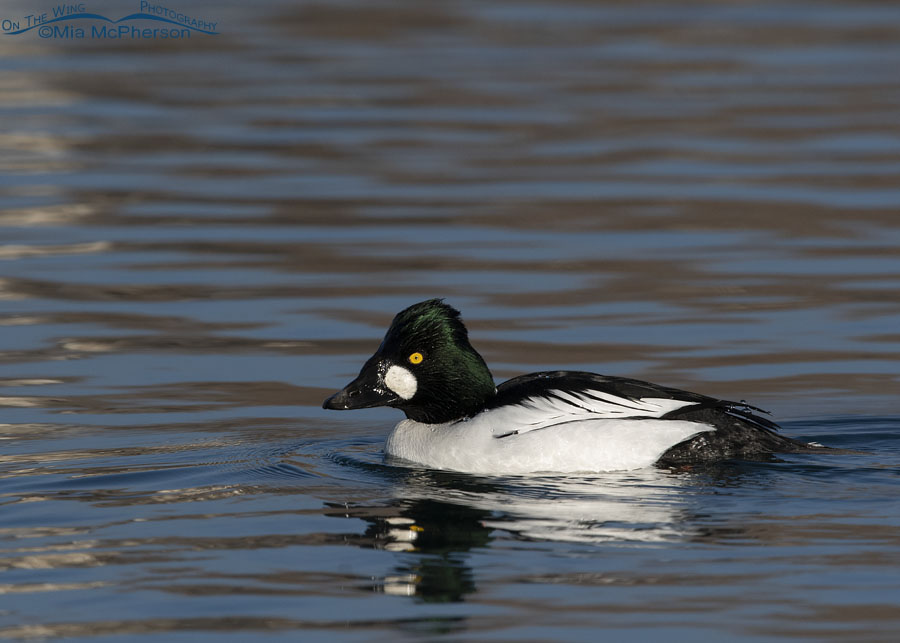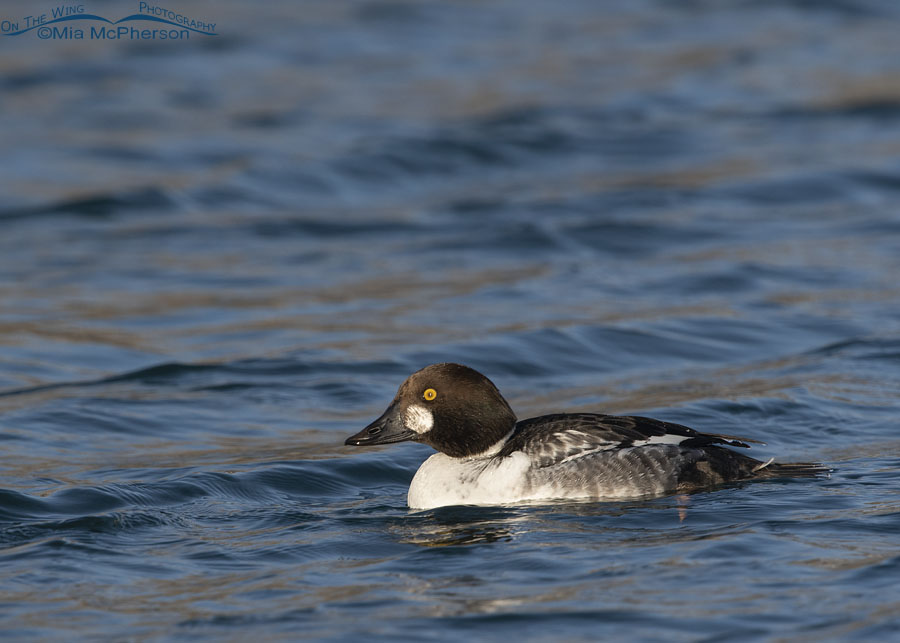 Adult drake Common Goldeneye side view – Nikon D500, f8, 1/2500, ISO 500, -0.3 EV, Nikkor 500mm VR with 1.4x TC, natural light
Adult drake Common Goldeneye side view – Nikon D500, f8, 1/2500, ISO 500, -0.3 EV, Nikkor 500mm VR with 1.4x TC, natural light
This is the time of the year when I look forward to seeing and photographing Common Goldeneyes on my local pond and in other ponds, lakes, rivers and marshes in the state. Common Goldeneyes do not breed in Utah but we do get to see them practically all winter long where there is open water. These diving ducks are challenging to photograph because of the high contrast between their dark and white plumage and because they are often wary of humans.
Both of these drake Common Goldeneyes were photographed on January 7, 2018, but they don’t look quite the same. The body shape is identical as is the shape of the bill but their plumage coloring is different.
The photo above shows an adult drake Common Goldeneye with a clear, yellow eyes, green iridescence on the head and neck with a white spot behind the all black bill. Most the the body of this male is a brilliant white that contrasts with the dark to black back, rump, wings and tail.
The males are especially stunning in great light.
 First winter drake Common Goldeneye side view – Nikon D500, f7.1, 1/1250, ISO 400, -0.3 EV, Nikkor 500mm VR with 1.4x TC, natural light
First winter drake Common Goldeneye side view – Nikon D500, f7.1, 1/1250, ISO 400, -0.3 EV, Nikkor 500mm VR with 1.4x TC, natural light
The Common Goldeneye in the photo above is also a drake but his coloring is different than the male in the first photo and that is because this male goldeneye is in its first winter. Note that his head and neck are brown instead of an iridescent green, that his body has less white and that his back, sides, rump and tail are brownish mixed with white. The amount of white and brown body feathers can vary from one individual to another.
During their first winter their eyes are yellow but not clear or as bright of a yellow as adult male Common Goldeneyes exhibit. The white patch, or loral spot, behind the bill at this age can vary from clear white to white with a brown smudgy appearance.
First winter drake Common Goldeneyes can be confusing for novice birders and bird photographers to sex but here is a hint, female Common Goldeneyes do not have the white loral spot behind their bills.
I haven’t seen any Common Goldeneyes on my local pond yet this winter but I am keeping an eye out for them.
Life is good.
Mia
Click here to see more of my Common Goldeneye photos plus facts and information about this species.


We usually get them in Long Island Sound, SW CT, but haven’t seen any yet this Winter…..and have seen only one long tail duck so far, despite our very cold weather. Thanks for sharing your terrific photos & knowledge
Echoing Marty. Thank you. And her.
Some young penguins plumage is so very different from the adult birds that early explorers assumed they were different species.
Thank you for the lesson.
We don’t have them here (Southern Europe)
Thank you for a great teachable moment this morning! I had no idea the first winter plumage was so different. It’s always a good day when I can start it by learning something new. 😃
Interrsting
Good morning lesson. Thanks!
Great post, thanks for the review!!